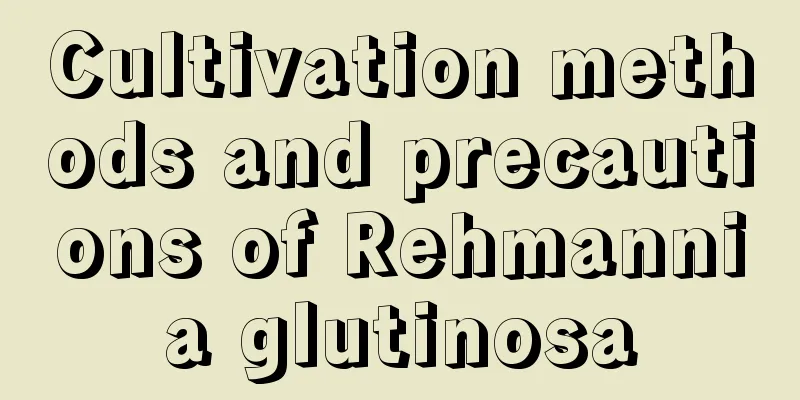Cultivation methods and precautions of Rehmannia glutinosa

1. Maintenance methods1. Soil: Rehmannia likes fertile soil. It is not suitable for sticky red soil and yellow soil. Generally, sandy soil is the most suitable for planting. 2. Water: Rehmannia has poor water absorption and a small root system. Too much water will cause its rhizomes to rot. Just keep the soil moist and water less frequently. There should be no accumulation of water. When it rains, drainage should be carried out in time to prevent flooding. 3. Nutrients: After planting, Rehmannia needs to be fertilized once. Generally, chicken, duck, pig manure and human manure can be used. For the rest of the time, you only need to apply fertilizer once every half a month, which is more conducive to the growth of Rehmannia. 4. Sunlight: Rehmannia is a plant that likes light and needs a good sunshine environment during its growing period. When choosing land for planting, do not choose a place close to tall crops, as they will block the sunlight of the place. But it is also not resistant to strong light, which is something you need to pay attention to. 2. Breeding techniques1. Weeding and pruning: As the Rehmannia grows, some weeds will grow in the soil. At this time, the weeds need to be dealt with in time, otherwise the weeds will absorb the nutrients in the soil. If the nutrients absorbed by the Rehmannia are insufficient, its growth rate will be affected. It is also necessary to trim off the dead branches and rotten leaves of Rehmannia in time to reduce nutrient loss. 2. Reproduction: Rehmannia is generally propagated by rhizomes. Choose strong rhizomes, dig them up and break them into short sections of 4 to 5 cm. After drying slightly, transplant it to soil with sufficient nutrients. Pay attention to drainage when it rains and wait until spring to transplant it. 3. Problem diagnosis and treatment1. Leaf spot disease: Leaf spot disease and wilt disease are common diseases after planting Rehmannia. At this time, you only need to use a double-volume Bordeaux liquid spray and pay attention to ventilation. 2. Pests: Cotton red spiders and butterflies are common after planting. At this time, you need to spray with carbofuran and dichlorodiphenyltrichloroethane. IV. Other issues1. How to survive the winter: In winter, if it is a potted plant, it needs to be moved indoors, and the temperature must be controlled to prevent frostbite. 2. Can it be placed indoors: It can be grown indoors, but considering the number of flowers blooming, we need to increase the sunlight appropriately, so that its flowers can bloom more brightly. |
<<: Daniel's breeding methods and precautions
>>: Breeding methods and precautions of Emperor Jade
Recommend
What fertilizer is best for blueberries?
As a popular berry fruit , blueberry is loved by ...
When is the best time to plant northern Chinese cabbage?
Planting time of Chinese cabbage in the north It ...
How to propagate the money tree
Illustration The first step is to select suitable...
Cultivation methods and precautions of Tithonia suspensa
1. Soil The swellonia has strong adaptability and...
Why doesn't the crab claw orchid bloom?
1. Why doesn't it bloom? 1. Temperature: The ...
Can I plant a Chinese toon tree in front of my door?
Can I plant a Chinese toon tree in front of my do...
Lily leaf disease prevention and control
1. Leaf blight Symptoms: The disease first occurs...
Cyclamen cutting method
1. Can it be propagated by cuttings? Theoreticall...
How to germinate peach seeds? Simple method to quickly germinate peach pits
How to Germinate Peach Seeds 1. Soak in warm wate...
How to water basil
Tips for watering basil Basil is a plant of the L...
How to protect outdoor flowers from cold
Protecting ground flowers from the cold: Covering...
How to plant and manage Allium macrocarpon
1. Planting method 1. Planting time: Allium gigan...
How to hydroponically cultivate spring fern
Spring Rain Hydroponics Method Remove dirt from t...
Does Mimosa bloom? Pictures of Mimosa bloom
1. Does Mimosa bloom? Mimosa will bloom. Its flow...
How to grow kiwano
soil The cultivation of prickly melon usually use...









